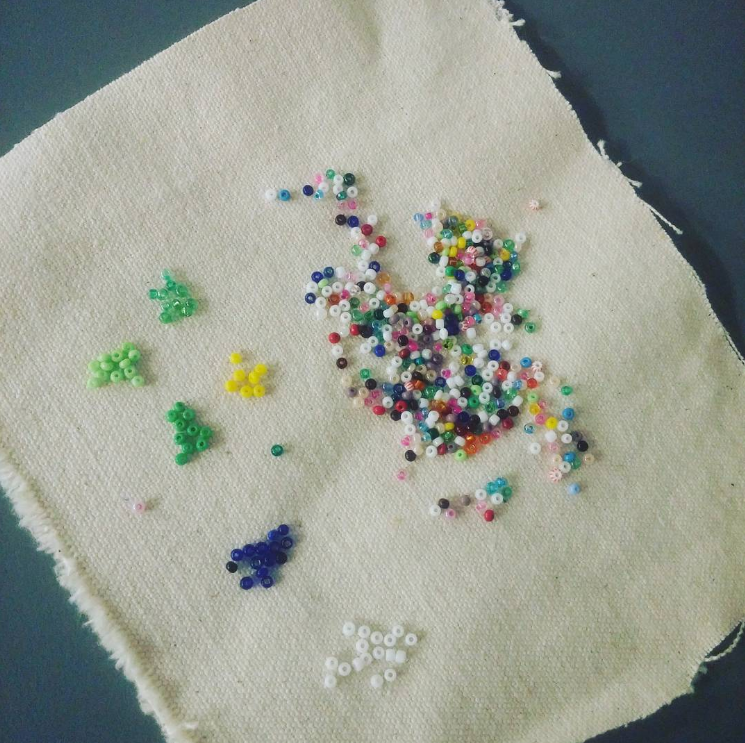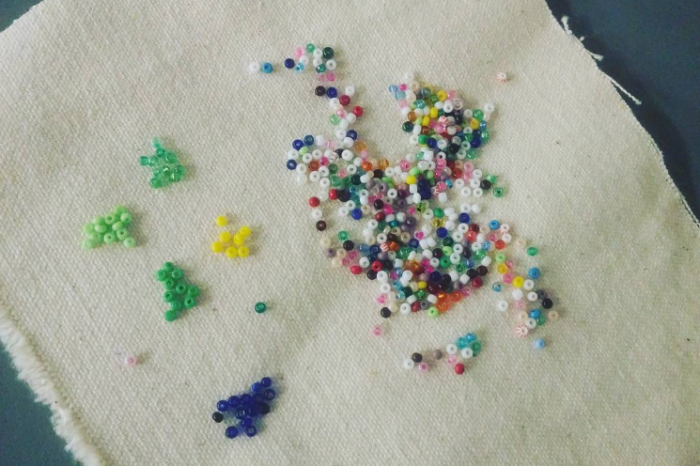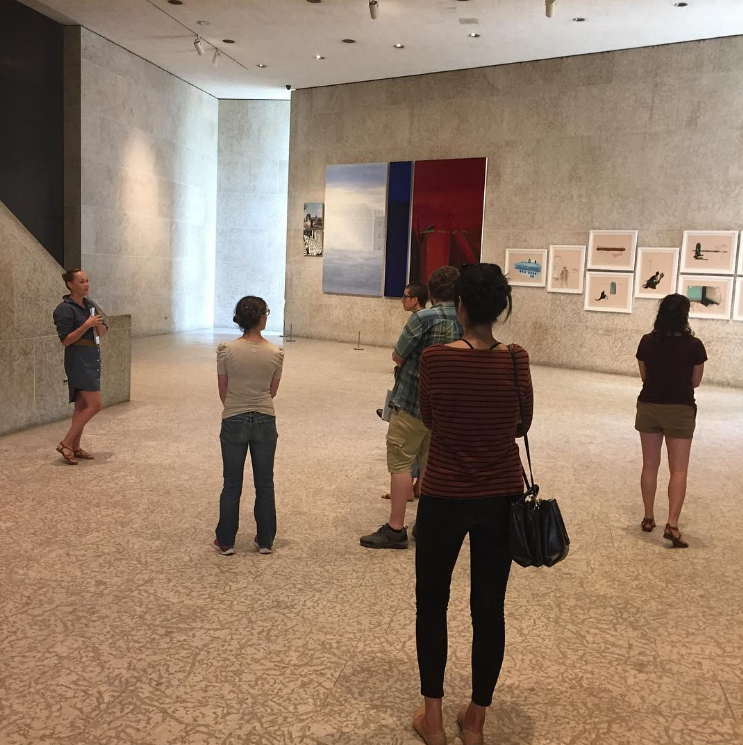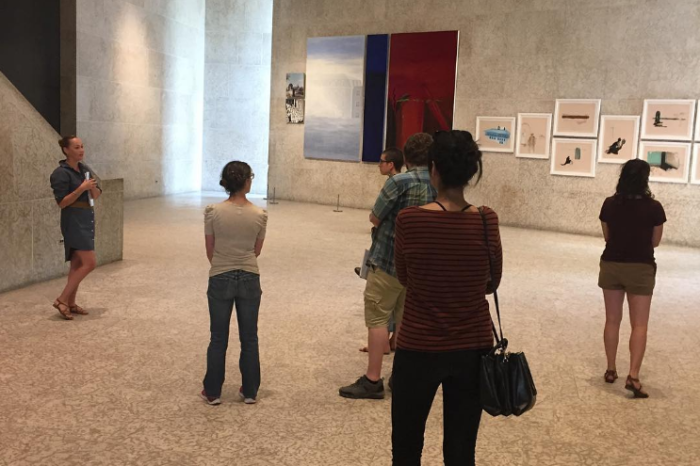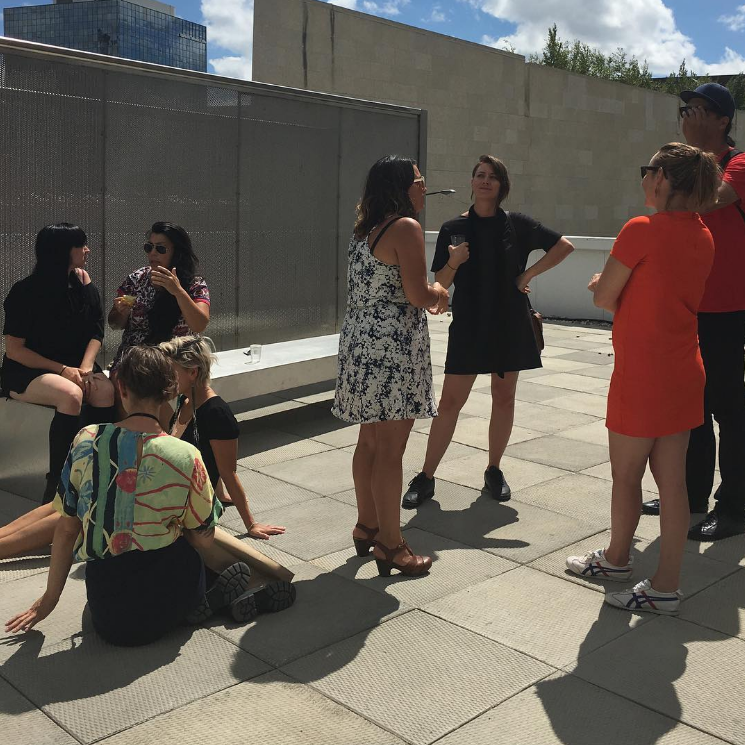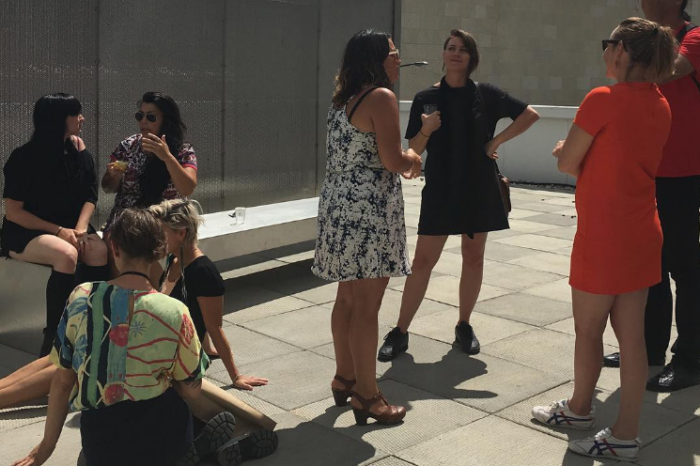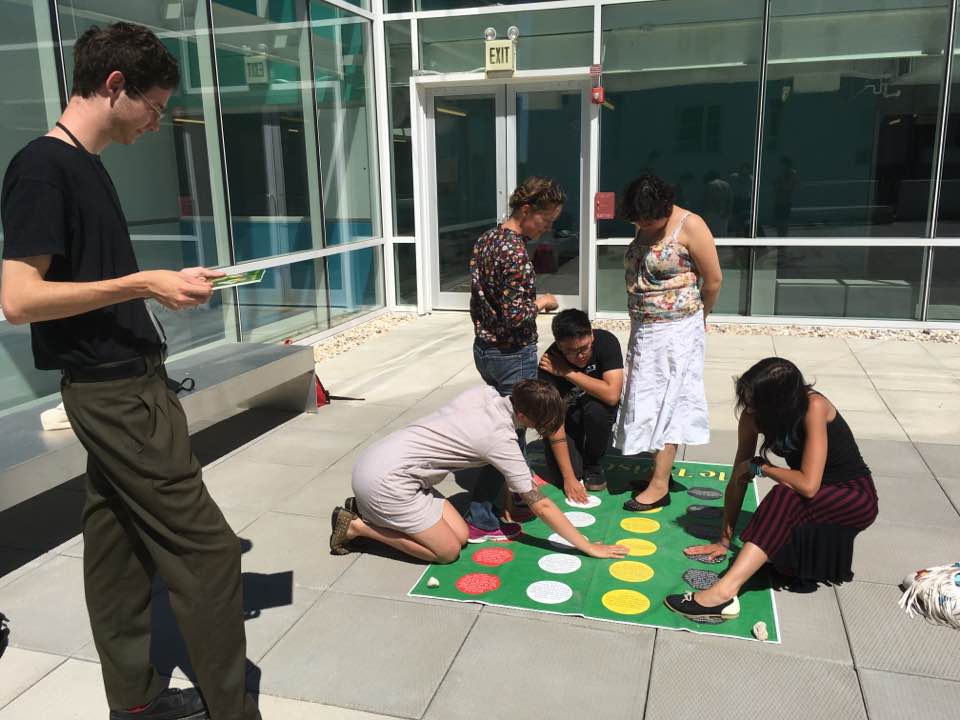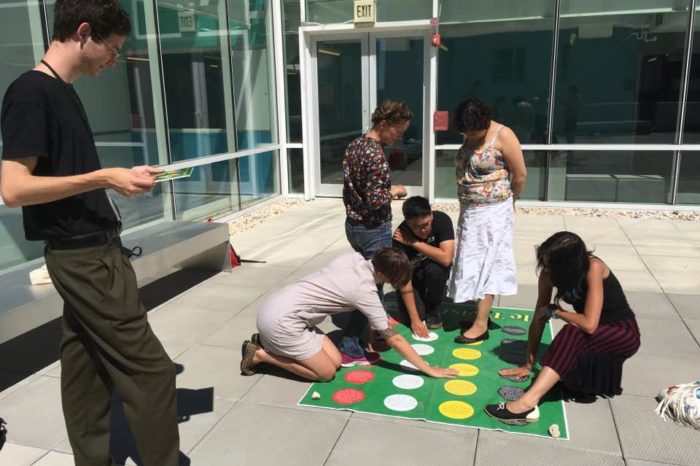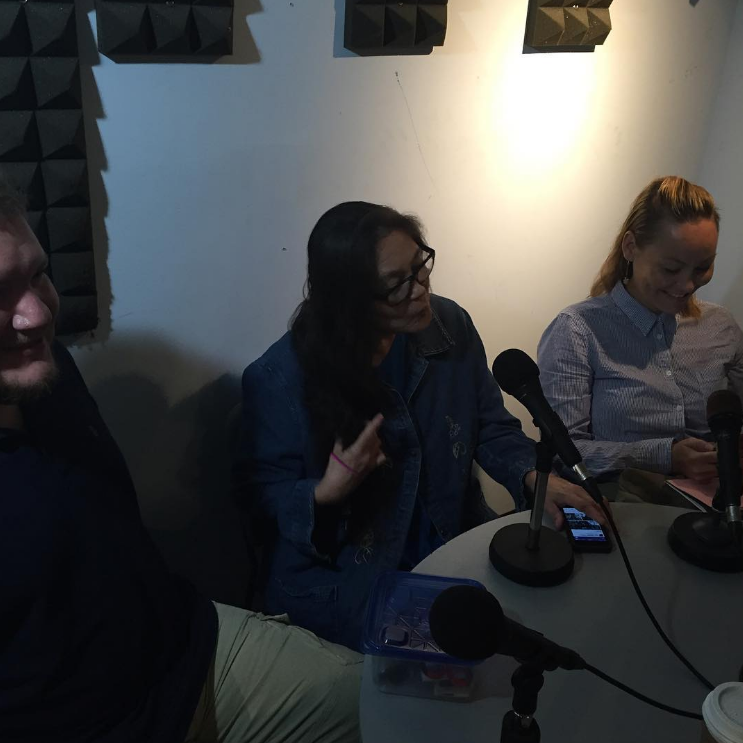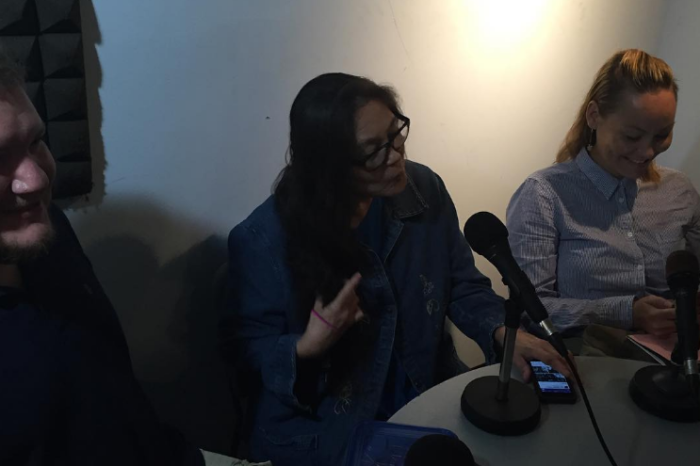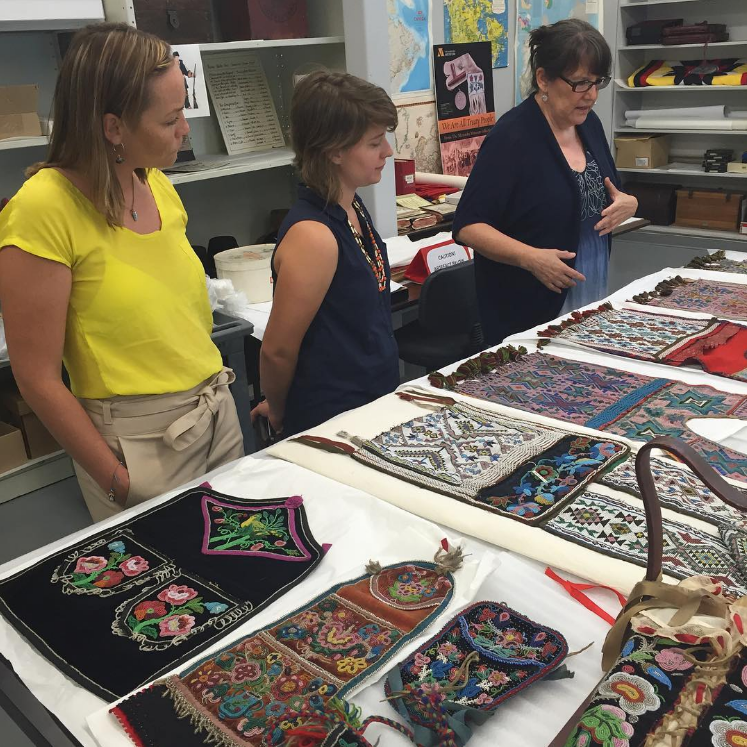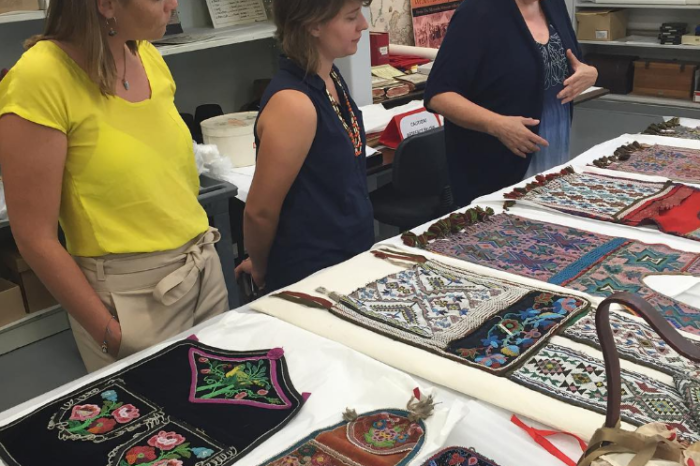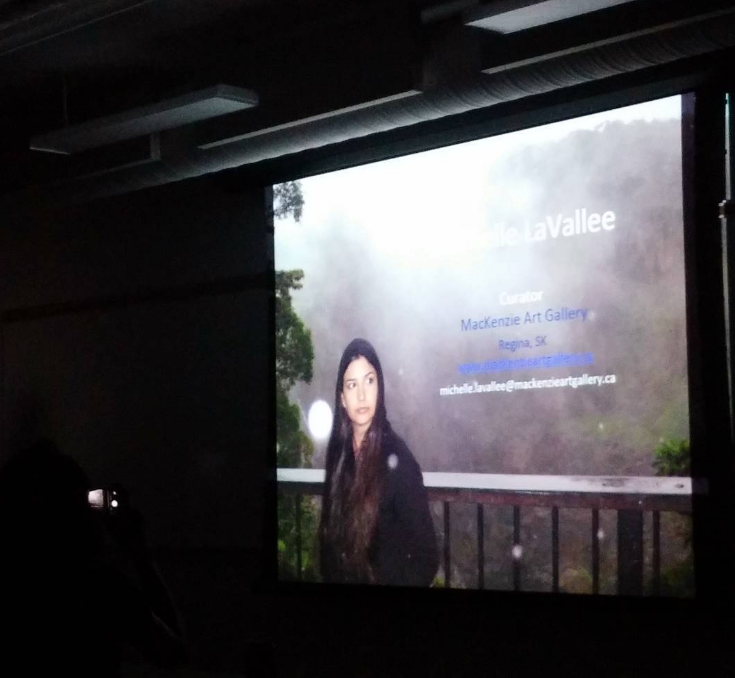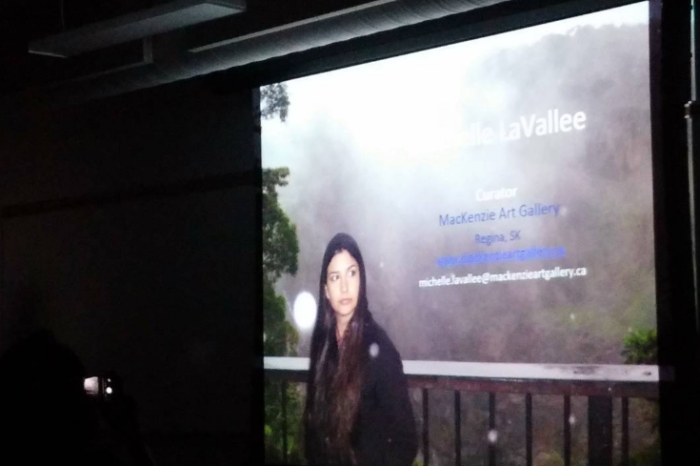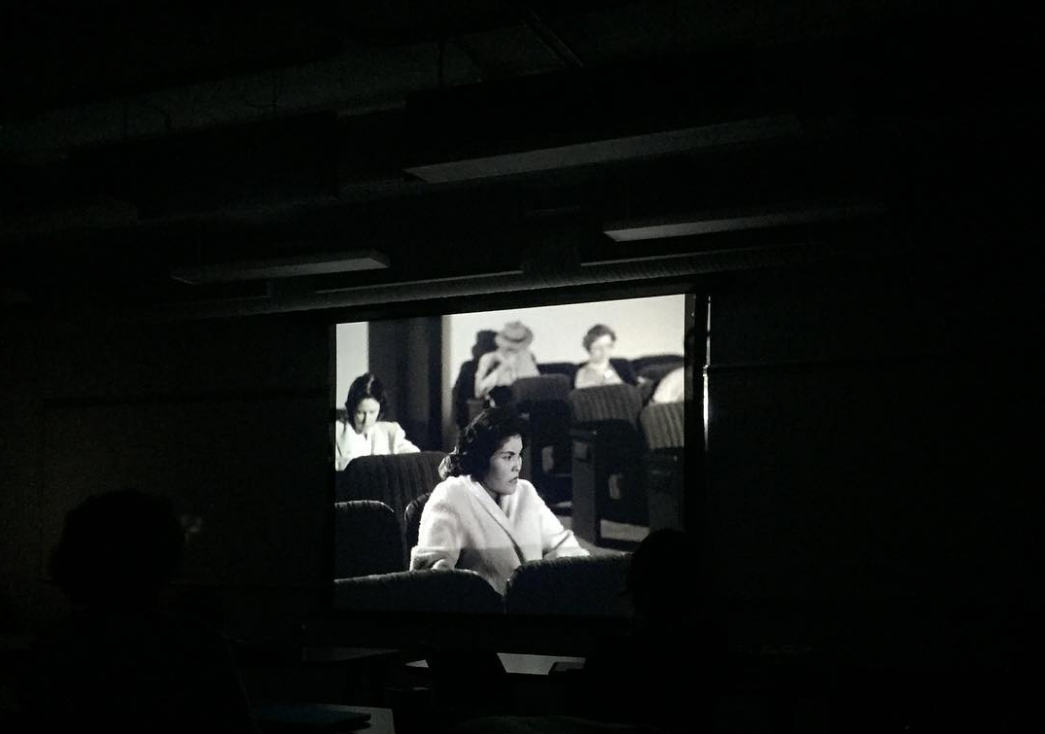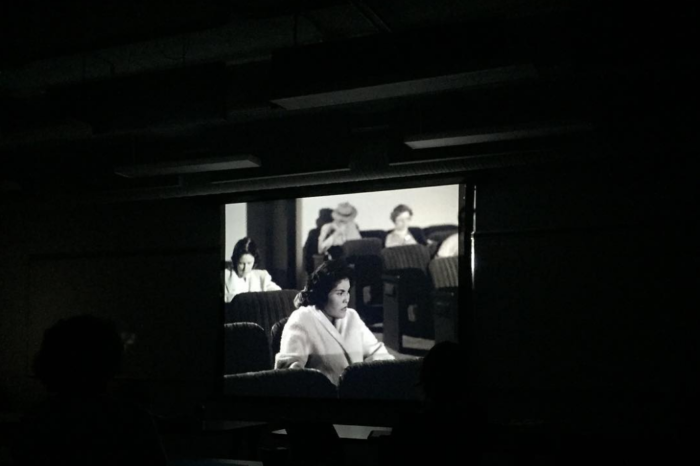Wood Land School
For the 2016 Summer Institute the Wood Land School was invited to Plug In ICA. Artist Duane Linklater and curator Jaimie Isaac lead a group of Indigenous and non-Indigenous participants through a series of texts, films, field trips and studio time for three weeks in the city of Winnipeg. These included:
– Curatorial tour of Qua’yuk tchi’gae’win: Making Good with Jaimie Isaac at the Winnipeg Art Gallery
– Manitoba Museum vault visit with Sherry Farrell Racette
– Visit to the Canadian Museum for Human Rights
– Curator talk with Michelle LaVallee. Link to a video of the talk here
– Curator talk with Julie Nagam
– Screening of The Exiles (1961) by Kent MacKenzie
– Curator Talk with Cathy Mattes (Curating as kitchen Table Talk) (Video of talk can be seen here)
– Curator talk with Daniel Jewesbury (Art and its Publics in ‘Post-Conflict’ Belfast). Link to video of talk here
– Open Studio, reception and exhibition
For this iteration of Wood Land School, Isaac and Linklater chose a single artwork as a conceptual point of departure for the school, Daphne Odjig’sThunderbird Woman (1973), featured in We are on Treaty Land, a group exhibition curated by Isaac at the Winnipeg Art Gallery from their permanent collection.
The powerful imagery of Daphne Odjig’s Thunderbird Woman was used as an icon and a symbolic starting point for this iteration of Wood Land School. It articulates Indigenous agency, the roles of guardianship and protection, and the notion of transformation. Isaac and Linklater posited this agency moving between rural and urban spaces, institutions, ideas, forms, and within an articulation of their respective contemporary art practices.
“We see Thunderbird Woman as a conceptual site of tremendous potential for our work at the Wood Land School. Over three weeks, we will read texts and watch films that complement the ideas situated in Thunderbird Woman. We hope the engagement with these materials and ideas will spur critical dialogues, long discursive situations, long takes, and artworks that culminate in an exhibition at its end.”
Wood Land School is an ongoing project with no fixed location or form. It seeks critical engagements within the realms of representation, film, contemporary art, land and politics in Turtle Island and beyond. Each iteration of Wood Land School carries forth with it a commitment to address the lack of structural inclusion, both historically and in the now, in a multiplicity of institutional spaces. It is a conceptual and physical space for Indigenous people, with Indigenous people deciding its directions, structures and functions. An important and vital component of the structure of Wood Land School since its beginning is the inclusion of non-Indigenous people into its fabric, as the faculty wants to include and not exclude those that wish to engage with the complexities of these aforementioned issues. Wood Land School was started in 2011 with the making of a small exhibition of works selected by Duane Linklater in a small studio space located above a store on the Nipissing First Nations in Ontario. Since then it has taken many forms such as residencies, seminars, film screenings and discursive happenings, in places such as The Banff Center for the Arts, Art Metropole, and Simon Fraser University. Currently there is a book of criticism being made with the support of Or Gallery Vancouver and SFU Galleries.
Daphne Odjig is an internationally renowned artist. Born September 11, 1919 and raised on the Wikwemikong Unceded Indian Reserve on Manitoulin Island (Lake Huron), Ontario Canada. She has long been recognized as an influential painter and one of the key attributors to the Woodland style. Her work is in key art collection across Canada and abroad. A retrospective of her work was exhibited at the National Gallery of Canada and she has had solo exhibition at the Institute of American Indian Arts Museum, Santa Fe and the McKenzie Art Gallery, Regina. She has received Honorary Degrees from seven universities including the university of Toronto, Western Ontario and Laurentian University, Sudbury. Numerous documentaries have focused on her life and work, Including The Life and Work of Woodland Artists (2003); Spirits Speaking Through (1981) and Colours of Pride (1973).
Faculty
Jaimie Isaac is an artist and curator. In 2015 she was awarded the Aboriginal Curatorial Resident position at the Winnipeg Art Gallery through the Canada Council for the Arts. As part of this position (as a collaboration between the WAG and Plug In ICA), Isaac will work with Duane Linklater to lead the Wood Land School as Plug In’s 2016 Summer Institute. Isaac holds a BA in Art History as well as an Arts and Cultural Management Certificate from the University of Winnipeg. Her Masters thesis from the University of British Columbia Okanagan focused on decolonizing curatorial praxis; mapping the agency and aesthetics of Indigenous Curatorial Praxis within contemporary Canadian art. Isaac’s work experience includes the Aboriginal Peoples Television Network, and the Arts and Cultural Industries of Manitoba as the Aboriginal programs and outreach manager. She has worked in art collections management, arts education and workshops, and held various roles in art administration. Isaac has worked collaboratively with projects as an artist, curator and writer. She most recently curated, We Are On Treaty Land an exhibition of work from the WAG’s collection and artifacts from the Manitoba Museum. She will launch a major group exhibition, Border X at the WAG in the Fall of 2016.
Duane Linklater is Omaskêko Cree, from Moose Cree First Nation in Northern Ontario and is currently based in North Bay, Ontario. Linklater attended the Milton Avery Graduate School of Arts at Bard College in upstate New York, USA, completing his Master of Fine Arts in Film and Video. He has exhibited and screened his work nationally and internationally at the Vancouver Art Gallery; Family Business Gallery in New York City; Te Tuhi Centre for Arts, Auckland; New Zealand, City Arts Centre, Edinburgh, Scotland; Institute of Contemporary Arts Philadelphia and the Utah Museum of Fine Arts, Salt Lake City. His collaborative film project with Brian Jungen, Modest Livelihood, was originally presented at the Walter Phillips Gallery at The Banff Centre as a part of dOCUMENTA (13) with subsequent exhibitions of this work at the Logan Centre Gallery at the University of Chicago and the Art Gallery of Ontario, Toronto. Linklater was also the recipient of the 2013 Sobey Art Award. He is currently represented by Catriona Jeffries Gallery, Vancouver.
Wood Land School at Plug In ICA: July 18th to August 5th, 2016
To read the bio’s of the 2016 participants click here
Participants
Jaime Black is a Métis multidisciplinary artist originally from Thunder Bay, Ontario. Influenced by her grandfather’s deep connection to the land and his experiences growing up in the bush, Black’s art practice emerged as a means to explore her relationship to her Métis identity. Her work engages in themes of memory, trauma, resistance and resilience. Largely self taught, Black began a full time arts practice after creating The REDress Project, an installation art project that draws attention to missing or murdered Indigenous women and girls. The project continues to tour across Canada and internationally and is currently displayed at the Canadian Museum for Human Rights. Jaime has recently been recognized by the Human Rights Museum as one of five women that should be household names in Canada, alongside leaders such as Nellie McClung and Viola Desmond. Recently Jaime has created a solo exhibition of new photographic works showing at Actual Gallery.
Lindsey Bond’s lens‐based work explores socio‐geographic issues in Canada. As a third generation Canadian, she creates pervasive imagery through a settler lens, exposing our need to reconnect with the ground we live on. Bond’s practice has begun to focus on collaborations and alliances between indigenous and settler communities to further investigate Canadian perception of space, memory and identity. Bond works with a photo-documentary ethic as a lift-off point to create street level photographic and postcard installations, books and video. Current projects address the affect of defunct raillines in Canada, and the journey across railbridges as a metaphor for personal transformation. Lindsey received her BFA in Photography from Emily Carr University of Art + Design and studied Visual Communications in Edinburgh, Scotland. Bond’s work has been exhibited across Canada including: Gallery 44; offsite installation on King and Spadina, Toronto; Latitude 53 Contemporary Visual Culture; public transit installation in the Edmonton LRT, Harcourt House Arts Centre and The Richmond International Film + Media Arts Festival.
Stephanie Duran Castillo was born in Lima, Peru in 1987 in a middle class family in Lima during Peru’s Internal Conflict (1980-1992). Stephanie decides to pursue animation at 17 after watching the series L’Opera Imaginaire (1), which portrays animation outside commercial usage. At 18 she starts studying in a technical school In Peru where she spends her time figuring out animation by herself. She directs three early experiments: the Comedy Kalasnikov and the dramas La Escalera and Noche de Fiesta which gain her some student awards in her city. She graduates with a film thesis in Andean Narrative applied to Animation in 2004. She travels around her country, visiting several provinces and talking to several artists and artisans of dance, music, ceramics and textile art.
At Lima she gets involved with self‐educated critics, filmmakers and cultural workers that are outside the official Lima circuit. As they all share a desire for a new cinema, the group gets involved in several initiatives to change the film scene. In 2011 Stephanie collaborates in launching the first Lima Independiente Film Festival. On September of 2011 Stephanie lands in Canada to attend university. While deeply involved in the department activities, Stephanie starts to explore the history of visual arts. She graduates with an experimental film, WEAVE, and starts producing incursions in installation, video and performance along with her regular writing and drawing. Stephanie is currently developing studies around public art and developing an archive film/fantastic short story called Genesis/Syndromes of a Century.
Danielle Fenn is an interdisciplinary artist from Winnipeg, Canada. She is currently finishing her undergraduate degree at the School of Art at the University of Manitoba. She has a background in creative writing and printmaking but now focuses her practice on performance and lens-based work. She was a recipient of the Undergraduate Research Award working for Sarah Ciursyek in the summer 2015. She led a team to a 3rdplace finish in the Game Changer competition at the University of Manitoba, for the design of a health empowerment app based on indigenous strategies and ideas of wellness. Her work explores ideas of identity continuity and performative healing.
Kristin Flattery
Boozoo, my name is Kristin Flattery and my spirit name is Blue Buffalo Woman. Currently living in Winnipeg, Manitoba, with a home community of Long Plain First Nation. I am an Anishinaabe and Dakota artist from Long Plain First Nation heavily involved in Indigenous issues. As a mother of two young boys as well as student deeply concerned for the next generation, I use my art as method to raise questions about historical and misleading inaccuracies. Drawing on the issues of Missing and Murdered Indigenous women, land and water politics including the key stone pipeline, mining and fracking, treaties, as well as exploring multi-cultural upbringings, identity crisis, and personal loss. I use painting, installation, photography, and performance art in my work.
Inspired by the painterly qualities of Daphne Odjig, Lawrence Paul, Ted Harrison, and the performative abilities of Praba Pilar, Wanda Luna, Rebecca Belmore, Margo Kane, and Adrian Piper.
I am a woman of mixed ancestry, my father is Irish and Belgian and my mother is Anshinaabe and Dakota. I am an Indigenous woman who walks in white skin. Growing up I loved all the history and culture my father’s side provided, however, I longed to look resemble my mother and sister. I would rub sand on my skin to become darker which later resulted in bronzer and various forms of make-up as I grew older.
I am going into my honours year through the School of Fine art at the University of Manitoba. Last year winner of the George Swinton memorial bursary, an award for UofM Indigenous artists with good grades. I reside on two student committees with three positions including an executive role and current winner of the Emerging Leader Award.
Lita Fontaine is an interdisciplinary artist based in Winnipeg, Manitoba. Often, her work explores the role of women in traditional and contemporary Indigenous society. She describes herself as tri cultural: Lakota, Anishinaabe and Metis. Fontaine received her BFA from the University of Manitoba School of Art in 2000 and her MFA from what is now the First Nations University of Canada in Regina in 2005.
Fontaine has had solo exhibitions at the Winnipeg Art Gallery in 2001Urban Shaman Gallery in 2013 and 2006. In 2015, her work was in the Winnipeg At Gallery’s We Are On Treaty Land exhibition. Since 2002, Fontaine has been artist-in-residence for the Seven Oaks School Division where she incorporates art experiences into the curriculum and the lives of students. Fontaine was a mentor in the Foundation Advisory Program of Mentoring Artists for Women’s Art in 2009.
Julia Anne Leach is a multidisciplinary artist from Winnipeg, Manitoba. Her practice investigates the life and history of her mother’s home, Sioux Valley Dakota Nation. Her fascination with psychogeography manifests itself in her recent piece, Desire Lines, a site-specific dérive in which she follows a pack of wild dogs as they wander the outskirts of the reserve. She is currently working with a member of the community, gathering and recording traditional and personal stories concerning life on reserve. Julia is also a member of The Long Weekend — a collective of Winnipeg artists, filmmakers, and designers who work under the aegis of Paul Butler’s Collage Party practice. She received her BFA Honours from the University of Manitoba in June 2016.
Jillian McDonald is a Canadian artist who lives in Brooklyn and dreams of the North. She has had solo exhibtiions at the Esker Foundation in Calgary, Air Circulation in New York, Rosenthal Gallery in San Francisco, Centre Clark in Montréal, and Hallwalls in Buffalo. Group exhibitions and festivals include The Chelsea Museum and The Whitney Museum’s Artport in New York, The Edith Russ Haus for Media Art in Germany, The International Biennial of Contemporary Art in Venezuela, The Sundance Film Festival in Utah, La Biennale de Montréal, and the Centre d’Art Contemporain de Basse Normandie in France. McDonald was featured in a 2013 radio documentary by Paul Kennedy on CBC’s IDEAS, titled Valley of the Deer, and reviewed in The New York Times , Art Papers , The Globe and Mail , The Toronto Star , Border Crossings , and Canadian Art . Critical discussion appears in several books including The Transatlantic Zombie (2015) by Sarah Juliet Lauro, and Deconstructing Brad Pitt (2014) edited by Christopher Schaberg. Her grants and commissions include The New York Foundation for the Arts, The Canada Council for the Arts, Turbulence, The Verizon Foundation, The New York State Council on the Arts, The Experimental Television Center, and Pace University. In 2012 she received the Glenfiddich Canadian Art Prize, and she has attended residencies including The Headlands Center for the Arts in California, Lilith Performance Studio in Sweden, The Lower Manhattan Cultural Council’s Workspace in New York, and Banff Centre for the Arts in Alberta. In 2016 she is in residence at the Lower Manhattan Cultural Council’s Process Space on Governor’s Island, NY and at KIAC in Dawson City, Yukon.
Fallon Simard is an Anishinaabe artist and scholar from Couchiching First Nation in Treaty #3 territory in the region of Northwestern Ontario. Their work examines Indigenous histories and injustices in the context of Canadian state inflicted violence. Fallon’s work is created from a queer Indigenous feminist framework that aims to induce a sense of reproductive justice within the classroom and their art practice. Fallon is a multi-media artist who works in digital based mediums and body media. Digitally, Fallon’s practice uses the modes of video, sound, and animation. Bodily, Fallon’s work includes, body and oratory performance, drawing, and sound generating.
Presently, Fallon is exploring sound, oratory performance, textual materials at the intersections of Anishinaabe history and cosmological epistemology. Fallon’s work will be focusing on the deities of the Anishinaabe cosmos and how they can be utilized and insurged into the water justice movement. Also, to assert that the iconography of the Mishibizhew (an Anishinaabe water deity) can assist in the dismantling of the Energy East Pipeline that currently proposes to go through Anishinaabe territory across Canada.
Emilie St.Hilaire is an interdisciplinary artist and current Humanities PhD student at Concordia University in Montreal, Canada. Originally from the francophonecommunity of St-Boniface, in Winnipeg Manitoba, Emilie attended the University of Manitoba’s School of Art for her BFA Honours and in 2014 she completed her Master of Fine Arts in Drawing and Intermedia at the University of Alberta.Emilie’s work is informed by her experience working in one-hour photo labs and various other jobs, her national and international travel which included four years in the Cayman Islands and many months in the US, Asia, and several Canadian provinces, and a general fascination with the rise of digital technology as a tool for personal expression and communication. Emilie has exhibited her work at galleries and festivals including: Harcourt House (Edmonton), Latitude 53 (Edmonton), DC3 Art Projects (Edmonton), The Toronto Urban Film Festival (Toronto), Ace Art (Winnipeg), Ryerson Image Centre (Toronto) and has received grants and awards from organizations including the Canada Council for the Arts, the Alberta Foundation for the Arts, and the Edmonton Arts Council. She has participated in artist residencies at Plug In Institute of Contemporary Art (Winnipeg), The Banff Centre (Banff), CAMAC art centre (Marnay-sur-Seine, France) and in 2015 Emilie was one of only two artists chosen from North America to attendthe WARP Contemporary Art Platform International Artist Village at the Brugge Triennale (Bruges, Belgium).
Phoenix Thomas
I am a Ojibwe, First Nations person of Walpole Island First Nations Reserve, and I was born half-indigenous to a father of said community and a mother originally from Nova Scotia. Being a half-native, who appears Caucasian, I was born and raised on the reserve but often felt removed and unable to really integrate into my own native community and could only pass as white if I repressed my indigenous heritage. I have based the creation and inspiration of my work on this binary of trying to find where I fit in on the spectrum of half-indigenous. Utilizing moments in my life where these two identities conflicted or played off one another, I create painterly installations, that question race, identity and indigenous issues. Through the use of anecdote, analogy and aphorism I tell stories in space, that combine text and painting, that see to tell viewers of a unique half-indigenous prospective, on trying to fit in and re-identify with a heritage that has been marginalized by majority society.



